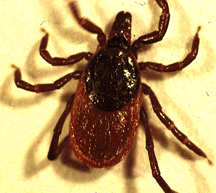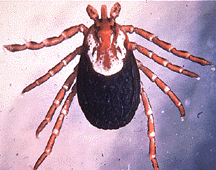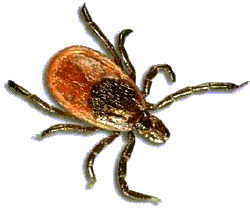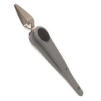|
Ticks, including tick
larvae and nymphs (the two life stages that precede the metamorphosis
into the adult tick form) favor a moist, shaded environment, especially
areas with leaf litter and low-lying vegetation in wooded, brushy or overgrown
grassy habitat. You do not need to be an avid outdoorsperson to come into
contact with infected ticks. Since many mammals other than deer and dogs
are hosts to the Ixodes ticks that carry Borrelia, Babesia,
Bartonella and Ehrlichia, infected ticks may be brought
into suburban and urban settings by wildlife moving through the areas
during the day and night. Your dog or cat can bring them into the house,
or you may get them sitting out in your yard. Other types of animals are
hosts to ticks carrying these organisms, including other mammals and other
mammals. Other arthropods, such as mosquitoes, may turn out to successfully
carry tickborne organisms.
In fact, one of the
biggest sources of ticks isn't wild animals, but your pet dogs and cats.
The other major source of ticks is just being outdoors in areas where
ticks are likely to be. Borrelia, and possibly other parasitic
organisms living in the ticks, drives the ticks to climb up weeds and
grasses and remain there during the day, waiting for a warm-blooded host
to walk by close enough to grab onto their clothing or skin. When you
are walking on hillside paths, the ticks will be congregated on plants
on the uphill side of the path. So, the very ground on which you walk,
the grasses you brush by or picnic on, and the fallen log you rest on
are the most likely places humans will come into contact with Ixodes
pacificus in California, Oregon, and Washington.
Thus, one must become
familiar with all the signs of these tickborne diseases in order to seek
appropriate testing and proactive, preventive treatment. Since only 50
percent or less of people finding ticks actually get the bull's-eye rash
(erythema migrans)--or any rash--from a tick bite, one cannot rely on
the presence or absence of such a rash to determine likelihood of infection.
| Remove
the tick properly. Using sharp pointed tweezers, or specially made
tick tweezers, grasp the tick as close to your skin as possible, as
close to its embedded mouthparts as you can. If you squeeze the body
or head, you risk compressing the guts and salivary glands and expelling
even more organisms through their mouth into your body. |
|
Do not twist the tick
or turn the tweezers as you pull out the tick. Pull out straight
with a slow, steady motion. Twisting may force more organisms
into your body, and may result in the head or more of the mouthparts being
left in your body.
Do not apply any substances
to the tick before removing it - no alcohol or nail polish, no petroleum
jelly or other ointments, and do not try to burn it out or otherwise convince
to let go of you. It won't let go. It will just happily keep on sucking
your blood and pumping pathogens into you.
|

Western Black-legged Tick
Ixodes pacificus
|

American Dog
Tick
Dermacentor variabilis
|

Rocky Mountain Wood Tick
Dermacentor
andersonii
|
Save the tick or any
nymphs or larvae that you find on you. Store them in a clean glass jar
or film container, tightly lidded and labeled with the date you pulled
the tick off you and the location you were when you acquired the tick.
Ideally, you should
have the tick tested right away to see what it contains. Ixodes pacificus
is currently the only western tick associated with Babesia, Bartonella,
Borrelia and Ehrlichia, but other ticks, such as the Dermacentor
variabilis (American Dog tick) can carry pathogenic organisms causing
diseases in humans and domestic pets (in this case, Rocky Mountain spotted
fever and tularemia); Dermacentor andersonii is also a vector
for RMSF.
A good rule of thumb:
have all ticks tested regardless of species. There is a fee associated
with tick testing.
Ticks can be sent to
IgeneX
Inc.
797 San Antonio Rd.
Palo Alto, CA 94303
800.832 3200
or delivered to your
county's public health laboratory:
Public Health Laboratory
3313 Chanate Road
Santa Rosa, CA 95404
707-565-4711 |
Marin
County HHS
Public Health Lab
415- 499-6849
|
Mendocino Public
Health Lab
501 Low Gap Road, Basement
Ukiah, CA 95482
707-463-4145 |
SOURCES
Centers for Disease Control & Prevention. Lyme
Disease Prevention & Control
Vredevoe, Larisa PhD.
Ticks
Commonly Encountered In California. University of California, Davis.
Vredevoe, Larisa PhD.
Background
Information on the Biology of Ticks. University of California, Davis.
Zimmer, Carl. Parasite
Rex. Free Press, Inc. 2000.
This
article is also available in PDF
format
for easy printing.
|




